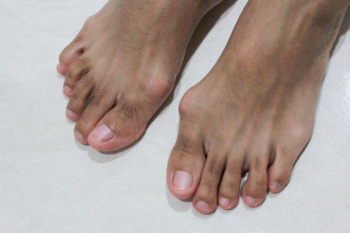Items filtered by date: October 2024
An Overview of Flat Feet

Flat feet, also known as fallen arches, is a condition where the arch of the foot collapses, causing the entire sole to come into contact with the ground. This condition can be present at birth or develop over time. In some cases, flat feet may not cause any symptoms, but in others, they can lead to pain and discomfort, particularly in the feet, ankles, and lower legs. The causes of flat feet can vary. In some individuals, weak or stretched tendons may contribute to the condition, while others may develop flat feet due to injury or age-related changes. Obesity and pregnancy can also increase the risk of developing flat feet due to added pressure on the feet. While flat feet can sometimes be managed with supportive footwear and exercises, severe cases may require medical treatment or orthotics for relief. If you have flat feet and are experiencing pain and discomfort, it is suggested that you are under the care of a podiatrist who can help you with relief techniques.
Flatfoot is a condition many people suffer from. If you have flat feet, contact Thomas Vail, DPM from Step Alive Foot & Ankle Center. Our doctor will treat your foot and ankle needs.
What Are Flat Feet?
Flatfoot is a condition in which the arch of the foot is depressed and the sole of the foot is almost completely in contact with the ground. About 20-30% of the population generally has flat feet because their arches never formed during growth.
Conditions & Problems:
Having flat feet makes it difficult to run or walk because of the stress placed on the ankles.
Alignment – The general alignment of your legs can be disrupted, because the ankles move inward which can cause major discomfort.
Knees – If you have complications with your knees, flat feet can be a contributor to arthritis in that area.
Symptoms
- Pain around the heel or arch area
- Trouble standing on the tip toe
- Swelling around the inside of the ankle
- Flat look to one or both feet
- Having your shoes feel uneven when worn
Treatment
If you are experiencing pain and stress on the foot you may weaken the posterior tibial tendon, which runs around the inside of the ankle.
If you have any questions please feel free to contact our office located in Findlay, OH . We offer the newest diagnostic and treatment technologies for all your foot and ankle needs.
Common Symptoms of Bunions

Bunions develop when the bones of the big toe shift, leading to a noticeable, often painful, bump on the side of the toe. People with bunions may first notice a bony protrusion at the base of the big toe, which can gradually enlarge, causing discomfort, especially while wearing narrow or tight shoes. Over time, a bunion may lead to additional symptoms such as redness from friction, calluses, and even stiffness in the toe, which restricts movement. Pain can be persistent or intermittent, especially with weight-bearing activities like walking. The affected toe might also deviate toward the neighboring toes, which can further alter the foot’s shape and increase pain. Bunions are commonly associated with wearing tight-fitting shoes, genetics, or both. A podiatrist can assess the level of severity and provide guidance on appropriate footwear, orthotics, and other treatments. In severe cases, surgery may be recommended to relieve discomfort and restore mobility. If you have a painful bunion, it is suggested that you schedule an appointment with a podiatrist for an exam and treatment.
If you are suffering from bunions, contact Thomas Vail, DPM of Step Alive Foot & Ankle Center. Our doctor can provide the care you need to keep you pain-free and on your feet.
What Is a Bunion?
A bunion is formed of swollen tissue or an enlargement of boney growth, usually located at the base joint of the toe that connects to the foot. The swelling occurs due to the bones in the big toe shifting inward, which impacts the other toes of the foot. This causes the area around the base of the big toe to become inflamed and painful.
Why Do Bunions Form?
Genetics – Susceptibility to bunions are often hereditary
Stress on the feet – Poorly fitted and uncomfortable footwear that places stress on feet, such as heels, can worsen existing bunions
How Are Bunions Diagnosed?
Doctors often perform two tests – blood tests and x-rays – when trying to diagnose bunions, especially in the early stages of development. Blood tests help determine if the foot pain is being caused by something else, such as arthritis, while x-rays provide a clear picture of your bone structure to your doctor.
How Are Bunions Treated?
- Refrain from wearing heels or similar shoes that cause discomfort
- Select wider shoes that can provide more comfort and reduce pain
- Anti-inflammatory and pain management drugs
- Orthotics or foot inserts
- Surgery
If you have any questions, please feel free to contact our office located in Findlay, OH . We offer the newest diagnostic and treatment technologies for all your foot care needs.
Causes of Nerve Pain in the Feet

Nerve pain in the feet often leads to burning sensations, tingling, numbness, and weakness, which may worsen at night. It usually originates from issues that affect the nerves in the spine or along their course down the leg. For example, a herniated disc or spinal stenosis can compress nerves in the lower back, leading to radiating pain from the back or leg into the feet. Peripheral neuropathy, which involves nerve damage in the extremities, can be caused by diabetes, injuries, or prolonged alcohol consumption. In these cases, people may experience altered sensations, sharp pains, or foot drop, which affect mobility. A podiatrist can assess and identify the underlying cause of nerve pain in the feet by conducting a variety of diagnostic tests. This foot doctor can also provide treatment options specifically designed to relieve discomfort and restore foot function. If you are experiencing symptoms of nerve pain in the feet, it is suggested that you schedule an appointment with a podiatrist for guidance.
Neuropathy
Neuropathy can be a potentially serious condition, especially if it is left undiagnosed. If you have any concerns that you may be experiencing nerve loss in your feet, consult with Thomas Vail, DPM from Step Alive Foot & Ankle Center. Our doctor will assess your condition and provide you with quality foot and ankle treatment for neuropathy.
What Is Neuropathy?
Neuropathy is a condition that leads to damage to the nerves in the body. Peripheral neuropathy, or neuropathy that affects your peripheral nervous system, usually occurs in the feet. Neuropathy can be triggered by a number of different causes. Such causes include diabetes, infections, cancers, disorders, and toxic substances.
Symptoms of Neuropathy Include:
- Numbness
- Sensation loss
- Prickling and tingling sensations
- Throbbing, freezing, burning pains
- Muscle weakness
Those with diabetes are at serious risk due to being unable to feel an ulcer on their feet. Diabetics usually also suffer from poor blood circulation. This can lead to the wound not healing, infections occurring, and the limb may have to be amputated.
Treatment
To treat neuropathy in the foot, podiatrists will first diagnose the cause of the neuropathy. Figuring out the underlying cause of the neuropathy will allow the podiatrist to prescribe the best treatment, whether it be caused by diabetes, toxic substance exposure, infection, etc. If the nerve has not died, then it’s possible that sensation may be able to return to the foot.
Pain medication may be issued for pain. Electrical nerve stimulation can be used to stimulate nerves. If the neuropathy is caused from pressure on the nerves, then surgery may be necessary.
If you have any questions, please feel free to contact our office located in Findlay, OH . We offer the newest diagnostic and treatment technologies for all your foot care needs.
Inspect Your Feet Regularly for Abnormalities if You're Diabetic
High Heels and Blisters

High heels are a popular shoe choice for many, but they can often lead to painful foot blisters. The structure of high heels places excessive pressure on specific areas of the feet, particularly the toes and the heel, which can cause friction against the shoe material. This friction, combined with sweat and prolonged wear, creates an ideal environment for blisters to form. To avoid this discomfort, selecting well-fitted shoes with adequate padding and support is essential. Wearing thick socks or protective blister pads can help reduce friction. It is also beneficial to gradually break in new heels by wearing them for short periods. Additionally, maintaining foot hygiene and keeping feet dry can minimize the risk of blisters. If you have problematic blisters from wearing high heels, it is suggested that you consult a podiatrist who can offer you relief and additional prevention tips.
High heels have a history of causing foot and ankle problems. If you have any concerns about your feet or ankles, contact Thomas Vail, DPM from Step Alive Foot & Ankle Center. Our doctor can provide the care you need to keep you pain-free and on your feet.
Effects of High Heels on the Feet
High heels are popular shoes among women because of their many styles and societal appeal. Despite this, high heels can still cause many health problems if worn too frequently.
Which Parts of My Body Will Be Affected by High Heels?
- Ankle Joints
- Achilles Tendon – May shorten and stiffen with prolonged wear
- Balls of the Feet
- Knees – Heels cause the knees to bend constantly, creating stress on them
- Back – They decrease the spine’s ability to absorb shock, which may lead to back pain. The vertebrae of the lower back may compress.
What Kinds of Foot Problems Can Develop from Wearing High Heels?
- Corns
- Calluses
- Hammertoe
- Bunions
- Morton’s Neuroma
- Plantar Fasciitis
How Can I Still Wear High Heels and Maintain Foot Health?
If you want to wear high heeled shoes, make sure that you are not wearing them every day, as this will help prevent long term physical problems. Try wearing thicker heels as opposed to stilettos to distribute weight more evenly across the feet. Always make sure you are wearing the proper shoes for the right occasion, such as sneakers for exercising. If you walk to work, try carrying your heels with you and changing into them once you arrive at work. Adding inserts to your heels can help cushion your feet and absorb shock. Full foot inserts or metatarsal pads are available.
If you have any questions please feel free to contact our office located in Findlay, OH . We offer the newest diagnostic and treatment technologies for all your foot and ankle needs.

